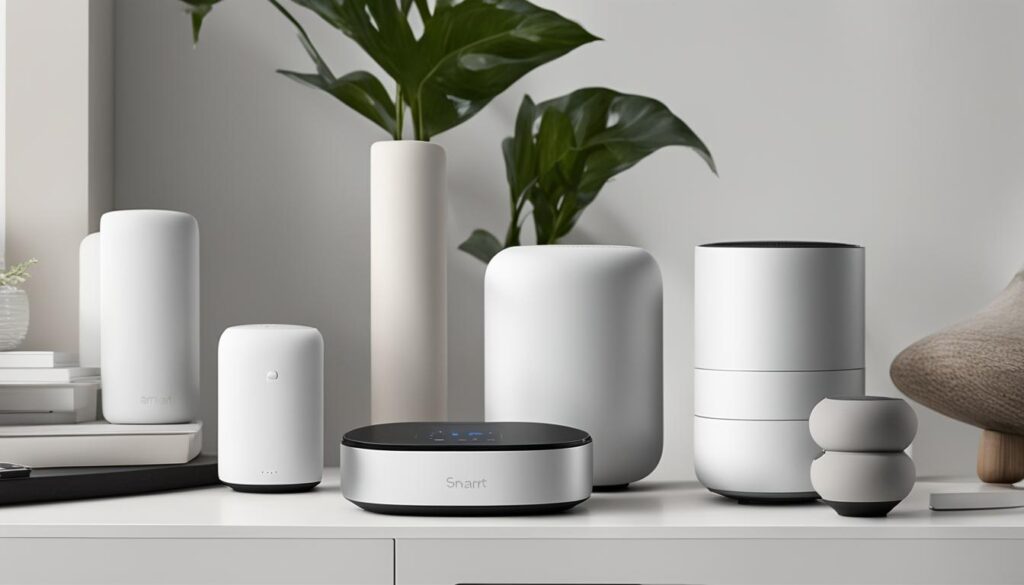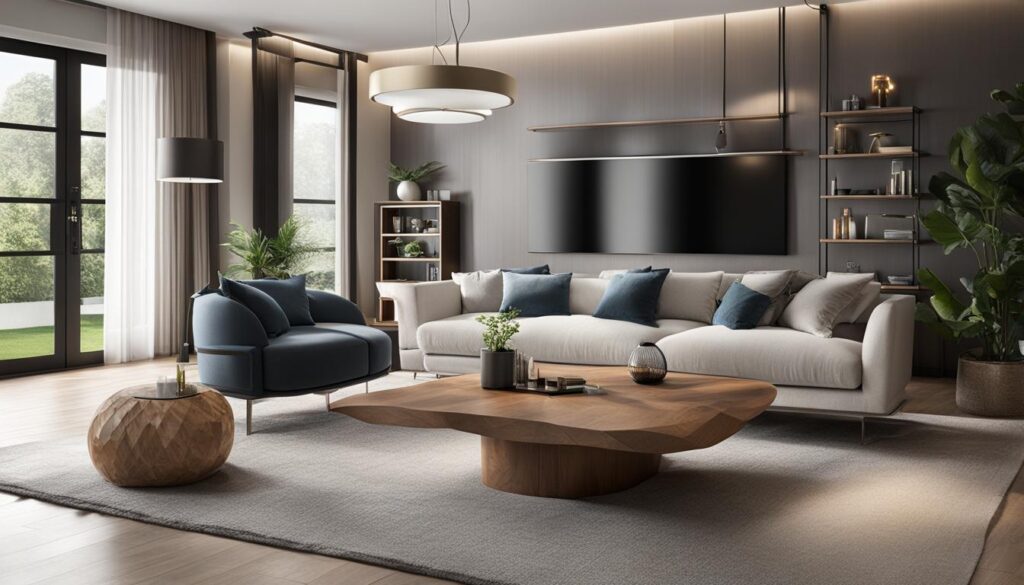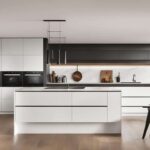Setting up a smart home doesn’t have to break the bank. With careful planning and strategic purchases, I can transform my living space into a smart home while staying within my budget. In this beginner’s guide, I will explore the steps and tips to help me set up a smart home on a tight budget.
Table of Contents
Key Takeaways:
- Setting up a smart home can be affordable with proper planning.
- Assess my needs and priorities before investing in smart home technology.
- Look for budget-friendly smart home devices that offer essential features.
- Consider smart home hubs and platforms that are accessible and affordable.
- Explore DIY and open-source solutions as a cost-effective option.
Assessing Your Needs and Priorities
Before diving into the world of smart home technology, it’s important to assess your needs and priorities. Take some time to think about the areas of your home that you want to automate and the features that are most important to you. Is energy efficiency a priority? Or do you value convenience and security? By clarifying your needs, you can make informed decisions when selecting smart home devices and systems.
Creating a smart home that meets your unique requirements begins with understanding what you need and prioritizing your setup accordingly. This will help you streamline your decision-making process and ensure that you invest in the right technologies for your home.
“I wanted to automate my home, but I wasn’t sure where to start. By assessing my needs and priorities, I realized that energy efficiency and security were my top concerns. This helped me prioritize my smart home setup and focus on devices that aligned with those goals.” – Michelle Thompson, Smart Home Enthusiast
One effective way to assess your smart home needs is to create a list of areas or tasks in your home that could benefit from automation. This could include controlling lighting, temperature, appliances, or even home entertainment systems. By identifying these specific areas, you can begin to see what aspects of your daily life can be improved through smart home technology.
Example: Areas of a Home That Can Benefit from Automation
- Living room: Control lighting and entertainment systems with a voice command or smartphone app.
- Kitchen: Automate appliances such as coffee makers, ovens, or refrigerators for added convenience.
- Bedroom: Use smart lighting solutions for creating a relaxing ambiance or scheduling wake-up lighting.
- Bathroom: Install smart shower systems that adjust water temperature and pressure, providing a personalized shower experience.
- Security: Enhance home security with smart locks, surveillance cameras, and motion sensors.
Once you have identified the areas that require automation, prioritize them based on their importance to you. Consider which features are essential and which ones would be nice to have but are not critical. This will help you allocate your budget and resources effectively, ensuring that you invest in the most relevant smart home devices.
By assessing your needs and priorities, you can make informed decisions and create a smart home that truly caters to your requirements. Remember, the goal is to enhance your overall living experience and simplify your daily routines through the seamless integration of smart home technology.
Choosing Budget-Friendly Smart Home Devices
When it comes to creating a smart home on a budget, selecting affordable smart home devices is key. While the market is filled with high-end and expensive options, there are also plenty of budget-friendly alternatives that provide the features you need without the hefty price tag.
One great way to save money is by considering devices like smart plugs, smart bulbs, and smart speakers. These affordable options can add convenience and automation to your home without breaking the bank. Let’s take a closer look at each of these devices:
Smart Plugs
Smart plugs are a simple yet powerful addition to any smart home setup. They allow you to control the power supply to any electronic device plugged into them using your smartphone or voice commands. With smart plugs, you can easily turn on or off appliances, lamps, or other devices, even when you’re away from home. Look for budget-friendly options from reputable brands like TP-Link or Wemo, which offer reliable performance without the premium price.
Smart Bulbs
Transform your lighting experience with smart bulbs that can be easily controlled using your smartphone or smart home hub. These bulbs offer features like dimming, color customization, and scheduling capabilities, allowing you to create the perfect ambiance for any room. Opt for affordable options like Philips Hue White bulbs or Wyze Bulbs, which provide excellent quality and functionality without breaking the bank.
Smart Speakers
Enhance your smart home setup with a budget-friendly smart speaker that doubles as a voice-controlled assistant. These speakers integrate with your smart home devices, allowing you to control them using voice commands. Look for options like the Amazon Echo Dot or Google Nest Mini, which offer high-quality sound and seamless integration with other smart devices, all at an affordable price point.
By selecting these affordable smart home devices, you can enjoy the benefits of a smart home without straining your budget. Take advantage of the convenience and automation they offer while staying within your means.

Stay tuned for the next section, where we will explore the world of smart home hubs and platforms, and how you can find the most budget-friendly options for your smart home setup.
Smart Home Hubs and Platforms
A smart home hub serves as the central control system for all your smart home devices. It’s essential to choose a hub that not only complements your budget but also provides a seamless smart home experience. While some hubs can be quite expensive, there are affordable options available that offer a wide range of features and compatibility with various smart devices.
When selecting a smart home hub, consider the following factors:
- Compatibility: Look for hubs that are compatible with a wide range of smart devices. This ensures that you can easily integrate your existing devices and expand your smart home setup in the future without compatibility issues.
- Affordability: Opt for hubs that offer affordable pricing options without compromising on functionality. Some hubs may require a one-time purchase, while others may have subscription plans. Determine the most cost-effective option based on your long-term smart home goals.
- User-Friendly Platforms: Choose a hub that provides a user-friendly platform for controlling and managing your smart home devices. Ensure that the platform has an intuitive interface and offers convenient features like voice control and mobile app integration.
Popular and affordable options for smart home hubs include:
- Amazon Echo: Amazon Echo devices feature the Alexa voice assistant, providing a user-friendly and affordable smart home platform. With Alexa, you can control a wide range of compatible devices using simple voice commands.
- Google Nest: Google Nest devices, powered by the Google Assistant, offer a seamless smart home experience. They integrate well with other Google products and services, making it easy to control and automate your smart home devices.
Having a reliable and affordable smart home hub ensures that you can efficiently manage and control your smart home devices from a single centralized location. With the right hub, you can unlock the full potential of your smart home setup without exceeding your budget.

DIY and Open-Source Solutions
If you’re looking to save even more money, consider exploring DIY (Do-It-Yourself) and open-source solutions for your smart home setup. These options provide a cost-effective way to customize your smart home according to your unique needs and preferences while also fostering a sense of achievement and creativity.
There are a variety of online resources and communities dedicated to DIY smart home projects. You can find step-by-step guides, tutorials, and forums where enthusiasts share their experiences and ideas. By tapping into these resources, you can gain the knowledge and confidence to create your own smart home devices and systems.
One popular option is to start with DIY home automation kits that come with pre-packaged components and instructions. These kits often include sensors, microcontrollers, and other electronic components necessary for building smart devices. They provide a great starting point for beginners, allowing you to gradually expand and customize your smart home setup.
If you prefer a more advanced approach, you can explore open-source software platforms that enable you to integrate and control your smart devices. Platforms like Home Assistant and OpenHAB offer extensive compatibility with a wide range of smart home devices and allow for advanced automation and customization.
Building a Smart Home with Raspberry Pi
Raspberry Pi, a popular single-board computer, is a versatile tool for DIY smart home enthusiasts. With its small size and low cost, Raspberry Pi can be used to create a variety of smart home projects, such as a smart security system, a media center, or a home automation hub. Its open-source nature and vast community support make it an ideal platform for DIY enthusiasts.
By taking a DIY and open-source approach, you not only save money but also have the freedom to tailor your smart home setup precisely to your needs. Whether you want to integrate unique sensors or create custom workflows, the possibilities are endless. Embrace your inner maker and embark on a journey towards an affordable and truly personalized smart home.
| Benefits of DIY and Open-Source Solutions | Considerations |
|---|---|
|
|
Smart Home Security on a Budget
Securing your smart home doesn’t have to be expensive. With the advancement of technology, there are now affordable smart home security devices available that can help protect your home and give you peace of mind.
When considering budget-friendly options for smart home security, there are a few key devices to focus on:
- Smart Doorbell Cameras: These innovative devices not only allow you to see who’s at your doorstep but also provide surveillance for your home. Look for options with motion detection, night vision, and two-way audio for added security.
- Motion Sensors: Motion sensors are a cost-effective way to monitor activity in your home. They can detect movement and trigger alarms or notifications, alerting you to any potential intruders. Place motion sensors strategically around your home for maximum coverage.
- Smart Locks: Replace your traditional lock with a smart lock that offers keyless entry and remote access. With a smart lock, you can control access to your home and receive notifications whenever someone locks or unlocks the door.
By incorporating these budget-friendly smart home security devices into your setup, you can enhance the security of your home without requiring a significant investment. Enjoy the convenience and peace of mind that comes with knowing your smart home is protected.
Pro Tip: Keep your smart home security system up to date
Just like any other technology, it’s important to keep your smart home security devices up to date with the latest firmware and software updates. Regularly check for updates from the manufacturer and install them as soon as they are available.
“Investing in smart home security devices doesn’t have to be a financial burden. There are affordable options that can provide a secure and connected home environment without breaking the bank.” – Smart Home Expert
| Smart Home Security Device | Features | Price Range |
|---|---|---|
| Smart Doorbell Cameras | Motion detection, night vision, two-way audio | $50 – $200 |
| Motion Sensors | Detects movement, triggers alarms or notifications | $20 – $50 |
| Smart Locks | Keyless entry, remote access | $100 – $300 |
Conclusion
Setting up a smart home on a tight budget is completely achievable with the right planning and smart choices. By assessing your needs, choosing budget-friendly devices, exploring DIY options, and focusing on smart home security, you can create a beginner’s smart home that enhances your living space without breaking your budget.
When it comes to setting up a beginner’s smart home, it’s important to prioritize your requirements. Think about the areas of your home that you want to automate and the features that matter most to you. This will help you make informed decisions and select the right devices that fit your needs.
Fortunately, there are plenty of affordable smart home devices available in the market. From smart plugs to smart speakers, these budget-friendly options can add convenience and automation to your home without putting a strain on your finances. Additionally, considering DIY and open-source solutions can provide you with cost-effective ways to customize your smart home setup.
Lastly, don’t forget the importance of smart home security. There are affordable options such as smart doorbell cameras and motion sensors that can help protect your home without breaking the bank. With the wide range of affordable options available today, there has never been a better time to set up your beginner’s smart home. So, go ahead and start your smart home journey – your future awaits!
FAQ
What is a smart home?
A smart home is a living space equipped with various devices and systems that can be controlled and automated through a central hub or smartphone. These devices can include smart plugs, smart bulbs, smart speakers, and more.
How do I set up a smart home on a budget?
Setting up a smart home on a budget is possible by carefully planning and selecting budget-friendly smart home devices. You can also consider DIY and open-source solutions to save money.
How do I assess my smart home needs and priorities?
Take some time to think about the areas of your home you want to automate and the features that are most important to you. Consider factors like energy efficiency, convenience, and security.
What are some budget-friendly smart home devices?
Budget-friendly smart home devices include smart plugs, smart bulbs, and smart speakers. These devices offer convenience and automation without a hefty price tag.
What options are available for smart home hubs and platforms?
There are affordable smart home hubs like Amazon Echo and Google Nest that offer seamless control and compatibility with a wide range of smart devices.
Are there DIY and open-source solutions for setting up a smart home?
Yes, there are DIY home automation kits and open-source software platforms available that allow you to customize your smart home setup according to your needs and preferences.
How can I secure my smart home on a budget?
You can opt for budget-friendly smart home security devices such as smart doorbell cameras, motion sensors, and smart locks to enhance the security of your home without a significant investment.


